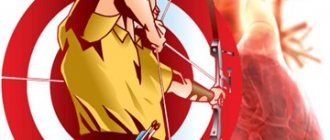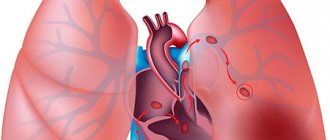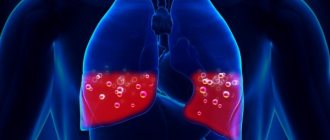General information
Obliterating endarteritis (otherwise known as thromboangiitis , thromangiosis or endarteriosis ) refers to chronic systemic diseases that affect small blood vessels, most often the arteries of the legs. The pathology develops in several stages, starting with inflammation ( panarteritis ), gradual narrowing of the lumen of blood vessels - gradual obliteration and until complete blockage, causing spontaneous development of gangrene and necrosis of tissues deprived of blood supply.
Despite the fact that endarteritis is a neurodystrophic pathology, most often localized in the lower extremities, changes are often simultaneously detected in the vessels of the heart, kidneys and even the brain. In this case, the type of obliteration is symmetrical - it develops on both legs, and also usually ascending and segmental - from the distal parts of the bloodstream to the proximal ones, with alternating areas of complete blockage by segments of vessels that have retained the lumen.
Most often it occurs in men 35-50 years old; smokers with many years of experience are at risk.
Consequences
As mentioned above, a hypertensive crisis is divided into uncomplicated and complicated. The latter type is accompanied by the development of fatal, life-threatening conditions and requires a slightly different approach than a crisis without complications. However, this does not deny the negative consequences of uncomplicated HA.
In both cases, a sudden increase in blood pressure leaves pathological changes in the body systems. A crisis condition refers to an emergency condition in medical practice, regardless of the presence of complications.
The negative consequences of a hypertensive attack are:
- hypertensive encephalopathy;
- acute ischemia of the heart or brain (myocardial infarction, stroke);
- dissecting aortic aneurysm;
- hemorrhage into the subarachnoid membrane of the brain.
Pathogenesis
The mechanism of obliterating endarteritis is based on allergic autoimmune reactions . autoantibodies , an increased content of immunoglobulins and circulating immune complexes are found in the bloodstream Sensitization of the wall occurs as a result of cooling, injury, exposure to chemicals or drugs. For example, after frostbite on the first day, the concentration of pressor substances in the bloodstream increases and the level of catecholamines further normalizes, which is accompanied by spasm of large vessels and capillary atony, thrombosis of arterial and, less commonly, venous vessels. As a result of prolonged spasms, their tone increases and complete occlusion . Severe irritants can paralyze the action of vasodilators and provoke blood stagnation, which is especially dangerous given the increased sensitivity of capillary walls to various stress factors.
Vascular inflammation leads to edema of the adventitial layer, thickening of the internal elastic membrane and cellular infiltration. Subsequently, fibrous changes occur in the distal arteries, which have a small diameter. The blockage occurs due to the formation of a white, organized thrombus consisting of cellular elements.
Disturbances are expressed in the form of occlusion of the arteries and can be located in the area of the soles, the back of the feet, in the calf muscles, which manifests itself in the form of severe pain, a feeling of cold, numbness, pallor, lack of pulse and is caused by irritation of nerve endings, accumulation of metabolic products in muscle tissue, lack of nutrients and oxygen.
The development of ulcerative-necrotic and gangrene processes is often sluggish, has weakly expressed possibilities for limitation, and can be complicated by lymphangitis with lymphadenitis .
What is vestibulo-atactic syndrome?
Vestibulo-atactic syndrome is a common pathology associated with disorders of the vascular system of the human body.
VAS is a progressive neurological disorder, which is expressed by a disorder of the vestibular apparatus, impaired coordination of movements against the background of insufficient blood supply to the brain. There are currently no medications or treatments to treat VAS, although some medications are effective in relieving certain symptoms of the disorder.
The first case of BAC was discovered in 1963 by a group of Spanish researchers. The second case was studied in 1984.
Historically, VAS has been difficult to classify due to variations in symptoms, severity, and time of onset. Vestibulo-atactic syndrome is also difficult to distinguish from other neurological disorders that cause similar symptoms.
Classification
Depending on the manifestations, endarteritis of the lower extremities is:
- Primary , with functional failure, manifested by rapidly passing pain and burning of the limbs after a long walk, as well as a decrease in the pulsation of the arteries of the foot.
- Subcompensated - accompanied by an increase in intermittent claudication, it is difficult to overcome even a few hundred meters, hair growth is impaired in areas of ischemia, due to paralytic expansion of capillaries, the skin of the legs turns purple, there is no pulsation of the arteries of the feet and legs.
- Decompensated - pain occurs even at rest, it is impossible to walk more than 200 meters, the formation of necrotic ulcers and the progression of atrophy .
- Necrotic , accompanied by destructive changes (edema, ulcers), the onset of wet gangrene of the toes is possible.
Buerger's thromboangiitis obliterans is a type of endarteritis, characterized by a remitting nature of the course, increasing ischemia and migratory thrombophlebitis . The disease begins with an allergic reaction and an increase in body temperature. Systemic changes affect the vessels of the skin, muscles, bones, nervous system and internal organs.
Treatment
Unlike, for example, a hypertensive crisis, this type does not pose a threat to the patient’s life.
This in no way means that signs of illness can be ignored.
When the first symptoms appear, you should contact a specialist (therapist, neurologist). The doctor carefully examines the medical history, conducts proper examinations and prescribes a course of treatment, which is aimed at eliminating the underlying disease, neurological and psychopathological syndromes, improving cerebral circulation and metabolic processes in the body.
To reduce the risk of relapse, sedatives are usually prescribed.
Drug treatment includes the use of vestibular suppressors (anticholinergics, antihistamines and benzodiazepines) and antiemetic medications.
Rehabilitation is aimed at accelerating the restoration of the function of the vestibular system and creating conditions for rapid adaptation. One of the important measures is vestibular gymnastics. It consists of a variety of exercises for eye movements, head movements, and gait training.
Remember that with this pathology, a sharp decrease in blood pressure is not permissible.
Symptoms of endarteritis
Symptoms of obliterating endarteritis of the vessels of the lower extremities are manifested mainly by local negative reactions caused by chronic ischemia - pain, discomfort, as well as:
- pallor, spotting or cyanosis of the integument;
- increased fatigue of the legs;
- weakening of pulsation;
- convulsions;
- cold feet syndrome;
- trophic ulcers;
- paresthesia - the appearance of a crawling sensation, burning, tingling, etc.
Necrotic changes usually begin on the big toe with a characteristic spotty cyanosis in the area of a minor bruise, abrasion, burn, or injury during a pedicure.
The first signs of endarteritis
Obliterating endarteritis of the vessels of the lower extremities manifests itself during rest in a horizontal position in the form of a feeling of numbness and mild pain, which can be easily relieved with sleeping pills and painkillers. In the future, the pain syndrome intensifies and the salvation for the patient becomes sleeping with his legs down, sitting with his limbs bent and massaging his feet and legs. This forced position signals endarteritis and after a few weeks leads to swelling of the limbs and flexion contractures. A significant increase in pain is usually caused by focal tissue destruction - necrosis and ulcers.
In the later stages of the disease, patients experience intermittent claudication - a phenomenon when severe pain occurs while walking and the person is forced to stop, but after some time he can walk again until the next attack of pain.
Diseases manifested by hypertensive crisis and their codes according to ICD 10
Diseases that can manifest themselves or are diagnosed after fixing a hypertensive vascular crisis are various types of chronic high cardiac pressure (hypertension) with different types of complications and have the following codes and classifications in ICD 10:
- I10 includes essential, or primary, hypertension - a recorded increase in pressure.
- I11 includes hypertension with cardiac complications.
- I12 includes hypertension with kidney complications.
- I13 includes complications of the kidneys and heart, as well as their more or less severe combinations - up to heart and kidney failure.
- I14 is missing.
- Codes I15 contain secondary hypertension, that is, those cases when an increase in pressure up to a crisis is caused by other diseases:
- endocrine: for example, pheochromocytoma or other hormonal neoplasms, as well as diabetes;
- renal: renovascular (renal-vascular) disorders, and others - disturbances in the outflow of fluid and swelling are directly related to vascular tone.
- unspecified reasons: an increase in blood pressure up to a crisis state can be caused by stressful situations and excessive physical exertion, taking certain medications, a reaction to the weather, fluid retention in the body, including due to the consumption of salty foods or lack of drinking.
Tests and diagnostics
To identify obliterating endarteritis of the vessels of the lower extremities, it is necessary to start by collecting data from complaints and anamnesis, conduct an examination and, using palpation, determine the degree of change in the peripheral pulse to determine the level of arterial obstruction. The pulsation may be clear, weakened or absent. Next, auscultation methods, functional tests and instrumental methods are used:
- auscultation to identify stenoses or aneurysmal dilations of blood vessels by finding systolic murmurs over the arteries;
- Ratashov and Goldflam tests , which determine areas of ischemia as a result of flexion-extension movements of the ankle joint for 2 minutes, manifested by paleness of the limb and severe fatigue;
- Leniel-Levastine test - an indicator of capillary blood circulation, revealing disturbances in blood flow while maintaining a white spot for more than 4 seconds after symmetrical pressure on both lower extremities;
- resography , which allows you to graphically record pulse fluctuations of the arterial walls and determine the degree of arterial insufficiency with the nature of the change in tone;
- capillaroscopy - providing information about capillary blood flow;
- Ultrasound - to measure blood pressure at various levels, determine the localization of narrowings and the degree of vascular patency, as well as identify arteriovenous anastomosis;
- angiographic studies and X-ray vasography to obtain a complete picture of narrowing of arteries and collaterals.
Embolism and arterial thrombosis
Included:
- heart attack:
- embolic
- thrombotic
Excluded: embolism and arterial thrombosis:
- basilar (I63.0-I63.2, I65.1)
- carotid (I63.0-I63.2, I65.2)
- cerebral (I63.3-I63.5, I66.9)
- coronary (I21-I25)
- mesenteric (K55.0)
- precerebral (I63.0-I63.2, I65.9)
- pulmonary (I26.-)
- renal (N28.0)
- retinal (H34.-)
- vertebrate (I63.0-I63.2, I65.0)
- complicating:
- abortion, ectopic or molar pregnancy (O00-O07, O08.2)
- pregnancy, childbirth and the puerperium (O88.-)
Prevention
To prevent problems with blood vessels in the legs, you should:
- give up such a bad habit as smoking;
- give preference to an active lifestyle, visit the gym, pool, or simply exercise regularly;
- maintain weight within normal limits;
- protect your feet from hypothermia;
- undergo regular medical examinations;
- give preference to a healthy diet and control the consumption of carbohydrates, especially simple ones.
Other forms of aneurysm and dissection
Included: aneurysm (branched) (false) (ruptured)
Excluded:
- aneurysm:
- aorta (I71.-)
- arteriovenous NOS (Q27.3)
- acquired (I77.0)
- cerebral (without rupture) (I67.1)
- torn (I60.-)
- coronary (I25.4)
- hearts (I25.3)
- pulmonary artery (I28.1)
- retina (H35.0)
- varicose (I77.0)
Causes
Doctors have not fully studied the causes of obliterating endarteritis. But experts put forward the opinion that the pathology develops as a result of an autoimmune reaction of the body, in which the body independently destroys its cells.
Doctors also identify predisposing factors for the development of the disease:
- unhealthy diet: predominance of fatty foods in the daily menu;
- smoking;
- chronic diseases;
- systematic hypothermia of the lower extremities;
- leg injuries;
- uncomfortable shoes.
Unfavorable factors lead to disruption of blood supply and oxygen supply to the legs, which is the main cause of obliterating endarteritis.
Additional facts
A hypertensive crisis is regarded in cardiology as an emergency condition that occurs with a sudden, individually excessive jump in blood pressure (systolic and diastolic). Hypertensive crisis develops in approximately 1% of patients with arterial hypertension. A hypertensive crisis can last from several hours to several days and lead not only to the occurrence of transient neurovegetative disorders, but also to disorders of cerebral, coronary and renal blood flow. During a hypertensive crisis, the risk of severe life-threatening complications (stroke, subarachnoid hemorrhage, myocardial infarction, ruptured aortic aneurysm, pulmonary edema, acute renal failure, etc.) increases significantly. In this case, damage to target organs can develop both at the height of a hypertensive crisis and with a rapid decrease in blood pressure.
Hypertensive crisis











